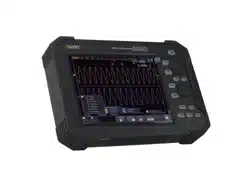Loading ...
Loading ...
Loading ...

3.Junior User Guidebook
8
Auto: Automatic mode and acquire waveform without triggering.
Trig: Trigger detected and acquire waveform.
Ready: Pre-triggered data captured and ready for a trigger. Click the
to force a trigger signal, which is mainly applied to the
"Normal" and "Single" trigger modes.
Scan: Capture and display the waveform continuously.
Stop: Data acquisition stopped.
4. Click to auto set.
5. The two blue dotted lines indicates the vertical position of cursor
measurement.
6. The pointer indicates the trigger position in the record length.
7. The T pointer indicates the horizontal position for the trigger.
8. It shows present triggering value and displays the site of present window in
internal memory.
9. Touchable icon is to enable (
) or disable (
) the touchscreen
controls.
10. It shows setting time (see "Config" on P50).
11. Wi-Fi is activated.
12. It indicates that there is a USB disk connecting with the oscilloscope.
13. Indicating battery power status (see "Display" on P51).
14. Multimeter window.
15. The waveform of CH1.
16. The pointer shows the trigger level position of the source in trigger menu.
17. The two blue dotted lines indicate the horizontal position of cursor
measurement.
18. The waveform of CH2.
19. The frequency of the trigger signal.
20. The icon shows the selected trigger type, e.g. represents triggering on
the rising edge for an Edge trigger. The reading shows the trigger level
value of the corresponding channel.
21. Click to show/hide the touchable menu panel.
22. It indicates the measured type and value of the corresponding channel. "T"
means period, "F" means frequency, "V" means the average value, "Vp"
the peak-peak value, "Vr" the root-mean-square value, "Ma" the maximum
amplitude value, "Mi" the minimum amplitude value, "Vt" the Voltage value
of the waveform's flat top value, "Vb" the Voltage value of the waveform's
flat base, "Va" the amplitude value, "Os" the overshoot value, "Ps" the
Preshoot value, "RT" the rise time value, "FT" the fall time value, "PW" the
+width value, "NW" the -Width value, "+D" the +Duty value, "-D" the -Duty
value, "WP" the Screen Duty, "FRR" the FRR, "FRF" the FRF, "FFR" the
FFR, "FFF" the FFF, "LRR" the, "LRF" the LRF, "LFR" the LFR, "LFF" the
LFF, "PD" the Delay A->B value, "ND" the Delay A->B value, "TR"
Loading ...
Loading ...
Loading ...
